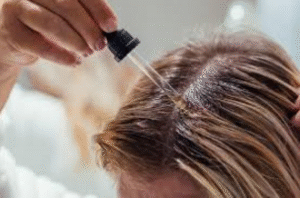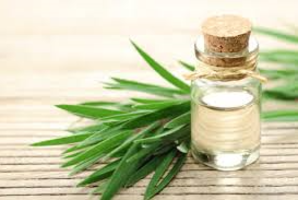Have you ever stared at your hairbrush, alarmed by the amount of hair left behind after a simple combing session? You’re not alone. Hair thinning and slow growth affect millions worldwide, leading many to search for natural solutions that actually work. Among these natural remedies, tea tree oil has emerged as a powerful ally in the quest for healthier, longer locks.
If you’ve been wondering how to use tea tree oil for hair growth, you’ve come to the right place. For generations, people have used tea tree oil for its therapeutic benefits. Indigenous Australians use the oil from crushed tea tree leaves, made from the leaves of the Melaleuca alternifolia plant to cure illnesses like colds, and coughs and other skin conditions.
Whether you’re dealing with a receding hairline, thinning patches, or simply want to boost your hair’s natural growth cycle, tea tree oil might be the natural solution you’ve been seeking.

Understanding the Connection Between Tea Tree Oil and Hair Growth
It’s essential to understand why this particular essential oil has gained such popularity in the hair care world. Tea tree oil is especially useful for hair treatment since it includes potent compounds:
- Terpinen-4-ol :This is the main active ingredient that provides tea tree oil with its antibacterial and anti-inflammatory qualities
- Anti-fungal properties: Helps combat scalp conditions like dandruff and seborrheic dermatitis that can impede hair growth
- Anti-inflammatory effects: Reduces scalp inflammation that may be inhibiting healthy follicle function
- Antimicrobial action: Clears bacteria and buildup that can clog hair follicles
How Tea Tree Oil Promotes Hair Growth
When exploring how to use tea tree oil for hair growth, it’s important to recognize that it works through several mechanisms:
- Unclogs hair follicles: By removing dead skin cells, excess oil, and product buildup that can suffocate follicles
- Increases blood circulation: Tea tree oil’s stimulating properties can increase blood flow to the scalp, giving hair follicles more nutrition.
- Balances oil production: Helps regulate sebum production, creating an optimal environment for hair growth
- Strengthens hair roots: The nutrients in tea tree oil can help fortify the hair from the root, reducing breakage
Research published in the Journal of Dermatological Science suggests that tea tree oil’s ability to penetrate the hair shaft and follicles makes it particularly effective at improving scalp health, which is the foundation for robust hair growth.
Tea tree oil’s advantages for hair growth and general hair health
When researching how to use tea tree oil for hair growth, you’ll discover numerous benefits beyond just length:
- Stimulates dormant follicles: Tea tree oil can help awaken sleeping hair follicles, potentially increasing hair density
- Prolongs the anagen phase: Might aid in extending the hair growth cycle’s growth phase.
- Reduces premature shedding: By strengthening the hair shaft and root, tea tree oil helps prevent early hair loss
- Dandruff control: The anti-fungal properties combat Malassezia, the yeast responsible for many dandruff cases
- Reduces itchiness and irritation: The anti-inflammatory properties soothe an irritated scalp
- Adds natural shine: Regular use can improve the natural sheen of hair, no need to use chemical ingredients
- Controls excess oil: Helps balance sebum production for those with oily scalp issues
Safety Guidelines on How to Use Tea Tree Oil for Hair Growth
Before applying tea tree oil, keep these crucial points in mind:
- Always dilute properly: When applied undiluted, pure tea tree oil’s high concentration can irritate the scalp.
- Patch test first: To check for any negative reactions, dab your inner elbow with diluted oil and wait a day.
- Consistency is key: Results come with regular, sustained use over time, not from occasional applications
- Quality matters: For the best effects and safety, use only organic, 100% pure tea tree oil.
Ways to Use Tea Tree Oil for Growth
Tea Tree Oil Hair Mask
Creating a nourishing hair mask is one of the most effective ways to use tea tree oil for promoting hair growth:
Ingredients:
- 2 tablespoons of carrier oil (coconut, olive, or jojoba oil work well)
- 5-7 drops of pure tea tree oil
- 1 tablespoon of honey (optional for added moisture)
Application:
- In a bowl, thoroughly combine all the ingredients.
- Then, apply to damp, clean hair, paying special attention to the roots and scalp.
- Massage with fingertips using circular motions for 5-10 minutes to stimulate blood flow
- Use a shower cap to cover the hair and leave for 30-60 minutes
- Wash with a mild, sulfate-free shampoo
Frequency:
Apply once or twice weekly for optimal results.
Tea Tree Oil Scalp Treatment
This simpler application focuses directly on the scalp for maximum follicle stimulation:
Ingredients:
- 1 tablespoon of carrier oil (jojoba or grapeseed oil are particularly good for scalp health)
- 3-5 drops of tea tree oil
Application:
- Mix oils thoroughly
- Use a dropper to apply straight to the scalp, or divide the hair into sections and apply with the fingertips.
- Massage gently for 5 minutes
- If at all feasible, let it be on the hair overnight or at least two to three hours.
- Wash with a gentle shampoo
Frequency:
Apply twice or thrice weekly for optimal results.
DIY Tea Tree Oil Shampoo Booster
Tea tree oil can improve your usual hair washing routine. How to make:
 Ingredients:
Ingredients:
- Your regular sulfate-free shampoo
- 2-3 drops of tea tree oil per tablespoon of shampoo
Application:
- Add tea tree oil to your shampoo in your palm just before applying
- Wash hair as normal, focusing on massaging the scalp
- Before rinsing, let the shampoo stay for two to three minutes.
- Follow with your regular conditioner
Frequency:
Can be used with every hair wash or alternated with regular shampoo.
Tea Tree Oil Spray for Daily Use
A convenient way to apply tea tree oil between washes:
Ingredients:
- 1 cup distilled water
- 2 tablespoons witch hazel (alcohol-free)
- 10-15 drops of tea tree oil
- Small spray bottle
Application:
- Mix all ingredients in the spray bottle and shake well
- Spray onto the scalp and roots of dry or slightly damp hair
- Massage briefly to distribute
- No need to rinse out
Frequency:
Can be used daily, especially on problem areas or thinning spots.
Combining Tea Tree Oil with Other Ingredients for Enhanced Hair Growth
When exploring how to use tea tree oil for hair growth, combining it with complementary ingredients can amplify the benefits:
- Tea Tree Oil + Rosemary Oil: Rosemary has been shown in studies to be as effective as minoxidil for hair growth. Adding 2-3 drops to your tea tree oil treatments can enhance circulation and stimulation.
- Tea Tree Oil + Aloe Vera: Aloe soothes the scalp while delivering amino acids and proteolytic enzymes that nourish hair follicles. Combine your tea tree oil mask with two tablespoons of aloe vera gel.
- Tea Tree Oil + Castor Oil: Castor oil is rich in ricinoleic acid, which improves blood circulation to the follicles. Its thick consistency helps the tea tree oil remain on the scalp longer.
- Tea Tree Oil + Peppermint Oil: The menthol in peppermint oil creates a cooling sensation that stimulates the scalp. Studies show it can promote a significant increase in hair growth.
Common Mistakes to Avoid When Using Tea Tree Oil for Hair Growth
Even when following guidance on how to use tea tree oil for hair growth, people often make these mistakes:
- Using undiluted tea tree oil: This may result in scalp irritation, redness, and even chemical burns.
- Inconsistent application: Hair growth requires patience and consistency; sporadic use won’t produce
- noticeable results
- Expecting overnight results: Hair typically grows about 1/2 inch per month; visible improvements usually take at least 1-3 months of regular use
- Overusing tea tree oil: More isn’t always better; excessive use can dry out the scalp and hair
- Not addressing underlying causes: If hair loss is due to hormonal issues, medical conditions, or nutritional deficiencies, tea tree oil alone may not be sufficient
What to Expect When Using Tea Tree Oil for Hair Growth
When using tea tree oil correctly for hair growth, most people experience a progression of benefits:
- Weeks 1-2: Noticeable improvement in scalp condition – less itchiness, flaking, and irritation
- Weeks 3-4: Reduction in hair fall during washing and brushing
- Months 1-2: Improved hair texture and shine; some may notice baby hairs emerging in previously thinning areas
- Months 3-6: More significant visible changes in hair density and length for most users who apply consistently
It’s important to document your journey with photos taken in the same lighting and position every few weeks to accurately track progress, as daily observation might not reveal the gradual improvements.

Tea Tree Oil for Different Hair Types and Concerns
Understanding how to use tea tree oil for hair growth based on your specific hair type and concerns can maximize results:
For Oily Hair and Scalp
- Dilution ratio: Use a lighter carrier oil like grapeseed or jojoba at a slightly higher tea tree oil concentration (4-5 drops per tablespoon)
- Application frequency: Can be used more frequently (3-4 times weekly)
- Additional ingredients: Add witch hazel or lemon juice to help control excess oil
For Dry Hair and Scalp
- Dilution ratio: Use more nourishing carrier oils like coconut or avocado with slightly less tea tree oil (2-3 drops per tablespoon)
- Application frequency: Limit to 1-2 times weekly
- Additional ingredients: Add honey or a few drops of argan oil for extra moisture
For Color-Treated Hair
- Precautions: Tea tree oil is generally safe for colored hair but start with a lower concentration
- Best carriers: Use color-safe oils like jojoba or sunflower oil
- Application timing: Apply at least 48 hours after coloring to prevent any interference with the color process
Lifestyle factors that Support Hair Growth Treatments with Tea Tree Oil
Use these helpful habits to optimize the benefits of tea tree oil for hair growth:
- Nutrition that is balanced: Make sure your diet contains enough protein, iron, zinc, and vitamins A, C, D, and E.
- Proper hydration: Drink at least 8 glasses of water daily to support healthy blood circulation to the scalp
- Stress management: Stress can cause hair loss, so try yoga, meditation, or other stress-reduction methods.
- Gentle hair care: Steer clear of harsh chemical treatments, tight hairstyles, and excessive heat styling.
- Regular exercise: Increases overall circulation, delivering more nutrients to hair follicles
FAQs
Can tea tree oil accelerate hair growth?
Tea tree oil doesn’t directly speed up the rate of hair growth, which is genetically determined to be about 1/2 inch per month for most people. However, it creates optimal conditions for growth by clearing blockages, reducing inflammation, and improving scalp health.
By eliminating factors that impede normal growth and strengthening existing hair to prevent breakage, tea tree oil can help you achieve your maximum natural growth potential over time.
When using tea tree oil to promote hair growth, how long does it take to notice results?
Most people begin noticing improvements in scalp condition within 1-2 weeks of consistent use. Reduced hair shedding typically follows in 3-4 weeks. For visible changes in hair density and new growth, expect to wait at least 2-3 months of regular application.
Are all hair types safe to use tea tree oil?
When appropriately diluted, tea tree oil is generally safe for all hair types. However, those with extremely sensitive skin or specific allergies should perform a patch test first. People with very dry hair should use tea tree oil less frequently and pair it with more moisturizing ingredients.
Those with color-treated hair should start with lower concentrations to ensure it doesn’t affect their color.
Is it possible for tea tree oil to aid with dandruff while encouraging hair growth?
Absolutely! One of tea tree oil’s most well-documented benefits is its effectiveness against dandruff. Its antifungal properties combat Malassezia, the yeast often responsible for dandruff, while its anti-inflammatory properties reduce the itching and flaking associated with this condition.
By addressing dandruff, tea tree oil removes a significant barrier to healthy hair growth, as excessive flaking and scratching can damage follicles and disrupt the growth cycle.
Should tea tree oil be applied to dry or wet hair for best results?
For treatments and masks intended to deeply penetrate the scalp, slightly damp hair is optimal as the moisture helps the oil spread more evenly and can enhance absorption. For leave-in treatments or overnight applications, completely dry hair is preferable as the oil can better adhere to the scalp without being diluted by water.
If using tea tree oil in a spray or as part of your regular shampooing routine, it can be applied to wet hair. The most important factor is ensuring the oil reaches your scalp rather than just coating the hair strands.
Conclusion…
When it comes to understanding how to use tea tree oil for hair growth, we’ve discovered that this powerful natural ingredient offers multiple pathways to healthier, stronger, and potentially longer hair. From its ability to unclog follicles and balance scalp oil production to its anti-inflammatory and antimicrobial properties, tea tree oil addresses many of the root causes that might be hindering your hair growth.
As with any natural remedy, individual results may vary based on your unique hair type, condition, and underlying factors affecting your hair growth. Begin your tea tree oil journey today with one of the methods we’ve outlined and remember to document your progress.
Your scalp—and your future hair—will thank you for this natural, nourishing addition to your hair growth regimen.



